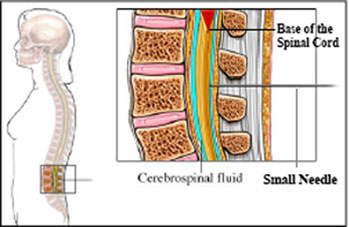Lumbar Puncture Procedure
What is a lumbar puncture?
Lumbar Puncture (LP), also called a spinal tap, is a procedure used to obtain a sample of cerebrospinal fluid (the fluid that surrounds the brain and spinal cord) for testing and/or pressure measurements. When performed by an experienced practitioner, the LP is safe and involves minimal risks or discomfort.
Is there any preparation for an LP?
You need to inform your physician if you are on any blood thinning medications (such as Coumadin, Plavix, or Aggrenox). You will be asked to stop taking these medications for 72 hours prior to the LP. You may also be asked to increase your fluid intake the day before (no alcohol). Have a light meal the morning of your LP and wear loose fitting clothing to the office.
 LP involves inserting a small needle between the vertebrae below the base of spinal cord. A small amount of fluid is collected. There is no risk for paralysis.
LP involves inserting a small needle between the vertebrae below the base of spinal cord. A small amount of fluid is collected. There is no risk for paralysis.
How is the LP performed?
You will be asked to sit on the edge of the exam table, in a hunched forward position by hugging a pillow OR you will lie on your side with your knees drawn up toward your chin. Your lower back will be scrubbed with a Betadine cleaning solution (let us know if you have any allergies to iodine). A local anesthetic medication is then injected into the skin to numb the site. The initial injection of the anesthetic stings for a brief moment – we will inform you when you will feel this so that you hold as still as possible. When the skin is numb, a small spinal needle is inserted into the back at the level of your waist. The spinal cord ends just above this level so there is no risk of injury to the spinal cord. The needle is passed gently between (not through) the bones of the spine until the spinal fluid is found. Approximately 3-4 tablespoons of fluid are removed and put into sterile tubes.
Are there risks involved?
You may experience minor pain, bruising or swelling of the skin where the needle was inserted. A post LP headache can also occur. Less than 10% of those having an LP report a headache. These headaches are usually mild and last 0-2 days and rarely may last as long as a week. More severe headaches or headaches lasting longer than a week may require an additional procedure called a “Blood Patch”.
Persons who faint or feel nauseous when having their blood drawn may have a similar flushing/fainting experience in response to an LP. All precautions are taken to anticipate these potential problems and minimize these risks. A very rare occurrence is infection from the tap itself; the risk for such infection is less than that of a regular blood draw.
What should I do after the procedure?
You will have a small band-aid covering the site, which you can leave on for a couple of hours. You may be asked to rest in office for 30 – 60 minutes and given fluids to drink. Continue to drink plenty of fluids (except alcohol), during the next 12 hours. Avoid heavy lifting and strenuous physical activity for 24 – 48 hours.
What should I do if I do get a headache?
The cause of the headache is leakage of spinal fluid around the puncture site. It will be important for you to lie down and keep your head flat. Only move in a slow manner – no jerking your head which can increase your headache, and no straining your back which may further cause a leak. Continue to drink plenty of fluids – caffeinated beverages (coffee, tea & colas) seem to ward off as well as help with spinal headaches. Mild analgesics like Tylenol, Ibuprofen or Aleve are suggested. You may also find ice packs to your forehead or back of neck helpful.
Low back discomfort is also relieved with rest; mild analgesics and a heating pad may also be used.
If you have any questions or concerns, please don’t hesitate to contact our physicians at (602) 258-3354 or Kathie Clarke RN, MS, CNS – BC Neuroscience Clinical Nurse Specialist, can be reached at EXT: 125.
